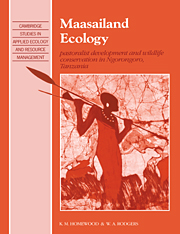Book contents
- Frontmatter
- Contents
- Preface
- 1 Management problems and applied ecology in Ngorongoro Conservation Area
- 2 Ngorongoro Conservation Area
- 3 Maasai of Ngorongoro
- 4 History, politics and perceptions in Ngorongoro
- 5 Management-oriented research in NCA
- 6 Range resources
- 7 Wildlife
- 8 Livestock ecology
- 9 Livestock and wildlife
- 10 Maasai ecology: development, demography and subsistence
- 11 Wildlife conservation and pastoralist development
- 12 Development interventions
- 13 Viewpoint
- References
- Author index
- Subject index
- Map: Ngorongoro Conservation Area, showing the main features and place names used in the text
6 - Range resources
Published online by Cambridge University Press: 08 February 2010
- Frontmatter
- Contents
- Preface
- 1 Management problems and applied ecology in Ngorongoro Conservation Area
- 2 Ngorongoro Conservation Area
- 3 Maasai of Ngorongoro
- 4 History, politics and perceptions in Ngorongoro
- 5 Management-oriented research in NCA
- 6 Range resources
- 7 Wildlife
- 8 Livestock ecology
- 9 Livestock and wildlife
- 10 Maasai ecology: development, demography and subsistence
- 11 Wildlife conservation and pastoralist development
- 12 Development interventions
- 13 Viewpoint
- References
- Author index
- Subject index
- Map: Ngorongoro Conservation Area, showing the main features and place names used in the text
Summary
Eishorua opa Enkai inkishu o nkujit, mikior intokitin neishoo iyiook Enkai God gave us cattle and grass, we do not separate the things God gave us
(Maasai proverb: Mol 1978)All grazing animals in the NCA, both wild and domestic, are ultimately dependent on the quantity, quality and distribution of primary production in the rangelands. Some 23 000 NCA Maasai are dependent on a quarter of a million livestock, themselves using some 3–4000 km of rangelands. The NCAA say that the pastoralists' herds are over-utilising the range resources, causing increasingly severe habitat degradation (Ole Kuwai 1981). Pastoralists say the changing pattern and intensity of grassland use by wild herbivores, and the increasing prohibition of livestock grazing in key areas, means they can no longer practice successful and sustainable subsistence pastoralism. This sums up the opposing sides of the conservation argument in NCA. Clearly the key to understanding much of this land use controversy lies in the status and dynamics of the range resources. Parallel conflicts prevail over the forested areas in NCA (Struhsaker et al. 1989, Chamshama, Kerkhof and Singunda, 1989).
This chapter sets out the main facts and debates on productivity, utilisation and dynamics of rangeland and forests in NCA. It reviews NCA grazing land productivity in the context of studies for Serengeti, East African and other African rangelands in order to emphasise the special nature of the NCA resources. The dynamics of long-term change, central to any evaluation of impacts, are then considered.
- Type
- Chapter
- Information
- Maasailand EcologyPastoralist Development and Wildlife Conservation in Ngorongoro, Tanzania, pp. 96 - 118Publisher: Cambridge University PressPrint publication year: 1991



